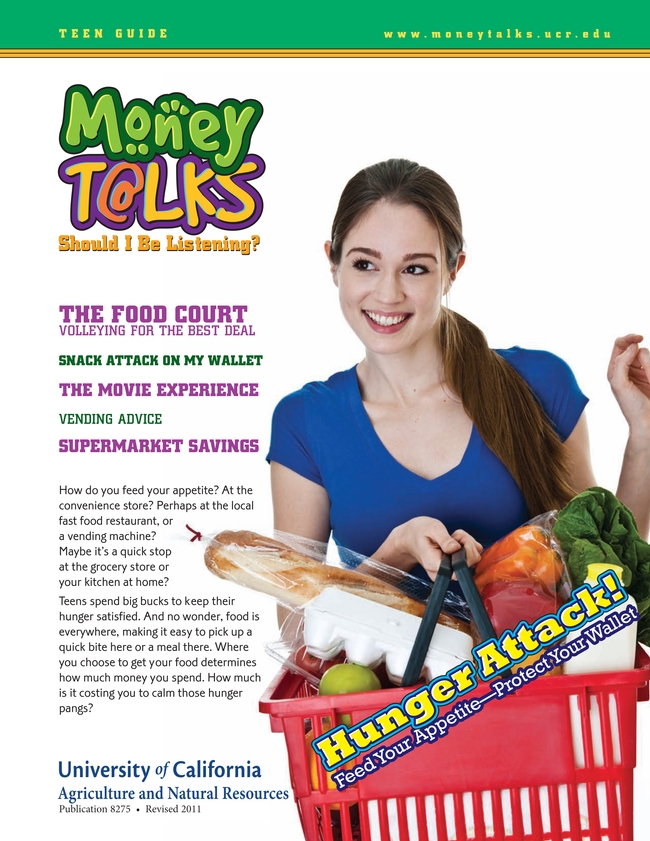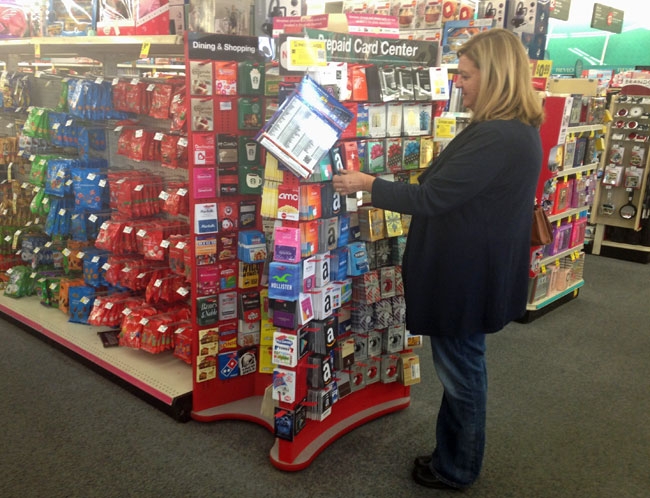- Author: Pamela Kan-Rice

Because studies show that the habits we start early in life often carry into adulthood, UC Cooperative Extension reaches out to teenagers to develop money-management skills with a program called Money Talks. After completing the UC Money Talks program, teens are more likely to find easy ways to save money.
One feature of Money Talks helps teens improve their eating habits at the same time they work on their financial health. “Hunger Attack!” teaches youth how to buy food and save money.
This curriculum was developed to address connections between poverty and childhood obesity, explained Katherine Soule, UC Cooperative Extension advisor for youth, families and communities in San Luis Obispo and Santa Barbara counties.
“When young people are hungry, they are likely to buy food from the most convenient location,” said Soule. “That could be a fast food restaurant or a vending machine, rather than buying nutritious food at a lower price at a grocery store.”
The Hunger Attack program suggests writing a list of the food items purchased and the price so teens can see how the expenses add up. They may reconsider whether they really need to buy an after-school snack.
“We designed Hunger Attack to provide the teens with consumer facts, as well as develop their decision-making and reasoning skills to make the best nutrition decisions for themselves while making good financial choices,” Soule said. “In other words, we're teaching teens to look for the best nutritional value for their food dollars.”

Money Talks provides money management techniques in magazine-style teen guides and an interactive website that features educational games and quizzes. The topics include money personality, easy ways to save money, shopping skills, car costs, developing skills for the workplace, buying snacks, savings accounts, checking accounts, e-banking, obtaining credit and credit cards.
Here's a sample quiz question:
The best time to go grocery shopping is when:
A. I'm really hungry.
B. I'm not hungry.
C. Everyone else is going
The answer is B. You're likely to buy more food when shopping on an empty stomach.
There is also a classroom curriculum for teachers, with leader's guides to accompany each of the teen guides. The leader's guides contain learning objectives; background information; discussion questions; activities with handouts, visuals, and links to the web site; a glossary of important terms; and additional resources. All of the materials are available in English and Spanish.
For more information, visit the Money Talks website at http://moneytalks4teens.ucanr.edu.
- Author: Jeannette E. Warnert

“Santa Cruz County farmers provide an array of quality fresh fruits and vegetables that can help residents to be healthier,” said Laura Tourte, UC Cooperative Extension advisor and one of the project's coordinators. “Everybody wins.”
The 40-page booklet – titled Fresh • Starts • Here – was developed by UCCE, the Palo Alto Medical Foundation (PAMF) and the Santa Cruz County Farm Bureau. It assembles a wide variety of resources into a compact form, with information about the seasons for local fruits and vegetables, nutritional information and directions for choosing, storing and preparing healthy foods using some of Santa Cruz County's top crops. Six farmers are profiled in the booklet along with four medical doctors and a registered dietitian, who provide suggestions about accessing fresh fruits and vegetables and reasons for eating them.
“It's not often you'll find stories about farmers and doctors in the same place, but it's a natural fit,” Tourte said. “Doctors know the health benefits of eating fresh fruits and vegetables, and farmers grow them.”
Dr. Karen Harrington, a family medicine physician, shared a seasonal salad recipe that includes cabbage, kale, tomatoes, bell peppers, cucumbers, scallions and parsley.
“Making a salad that uses many different fruits and vegetables and keeps for several days is a great and convenient way to help improve your health,” she said.
Pediatrician Casey Schirmer is pictured in the guide with his cousin Joe Schirmer, owner of an organic farming operation in Santa Cruz.

The development committee, local farmers and physicians donated their time and effort to the project. UCCE funded the printing of the first 2,000 copies of the booklet. The guide was recently the focus of three outreach events at PAMF clinics, where farmers and PAMF staff teamed up to distribute the guide and other health information at no cost to PAMF patients, visitors and staff. A Spanish language version – which was funded with contributions from UCCE, PAMF and Lakeside Organic Gardens – is in press and expected to be available to the community later this month.
Tourte said the committee has received more requests for the guide than they can currently accommodate. They are now seeking funding to print additional copies, and planning to partner with others in the community to share the information.
“This guide, two years in the making, is our group's foundational piece. It is the beginning of many more activities and educational events we have planned for the future,” Tourte said.
An initiative to enhance competitive and sustainable food systems is part of the UC Division of Agriculture and Natural Resources Strategic Vision 2025.
- Author: Patti C. Wooten Swanson

While working on this story, I discovered these ducks are on the U.S. Public Interest Research Group's list of 24 potentially hazardous toys. Why? Laboratory tests revealed high levels of a dangerous toxic chemical in the ducks.
The Trouble in Toyland 2014 report released this month warns shoppers that there are dangerous and toxic toys on store shelves this holiday season. The study found toys that you may want to avoid, that…
- are made of materials containing toxic chemicals such as lead
- have small parts that could choke a child if swallowed
- contain powerful magnets that if swallowed could cause intestinal injuries
- make noises loud enough to damage hearing.
So, how can you choose toys that are safe for your child (or nieces, etc.)? One way is to pick age-appropriate toys.
Many manufacturers label toys for age appropriateness. The guidelines factor in a child's developmental stage and the safety issues relevant for the child's age. That means that if you buy a toy labeled as appropriate for ages 4-5, for your “very advanced” 2 ½ year old daughter, you may be exposing her to safety risks.
In deciding what to buy, consider these guidelines from a fellow Cooperative Extension human development expert at Cornell University:
Children under 3: The biggest threat is toys with small parts that could choke them. Avoid marbles, magnets, and games with balls that are less than 1 3/4 inches in diameter. For example, when buying toys such as stuffed animals check to be sure eyes, noses, and other parts are attached securely. Otherwise a part might come lose and be dangerous if swallowed. (Follow this guideline for an older child who still mouths his toys.)
Children 3 to 5: Toys with straps or cords that fit around the neck, such as a toy guitar, is risky because a child could get the cord wrapped around her throat and be strangled. Avoid such toys until the child is older. Or to be safe, cut off cords, strings or straps until the he is older. Avoid toys that are made of thin plastic that can break into pieces or become jagged. Take the batteries out of loud toys or cover speakers with tape.
Children 6 to 12: Avoid toys with sharp or pointed edges, as well any that might easily break into pieces with sharp edges. The Consumer Product Safety Commission (CPSC) recommends NOT buying electric toys with heating elements for children under 8 years old. It advises anyone buying bikes, scooters, skateboards or inline skates to also buy protective gear such as a helmet, kneepads, elbow pads, and wrist guards.
Children and Teens:
- Magnets: Although the risk scenarios differ by age group, the danger is the same. When two or more magnets are swallowed, they can attract one another internally, resulting in serious injuries, such as small holes in the stomach and intestines, intestinal blockage, blood poisoning and even death. When a magnet has to be removed surgically, it often requires the repair of the child's damaged stomach and intestines.
- Toy Guns: Whether or not to buy toy guns is an individual matter. The University of Michigan Health System and recent events suggest toy guns should not look like real guns, and they should be brightly colored in order to be instantly recognizable as toys.
For more information, see Tips for Buying Safe Toys.
Patti Wooten Swanson, Ph.D., is a University of California Cooperative Extension nutrition, family and consumer science advisor in San Diego County.
- Author: Jeannette E. Warnert

“In the past, gift cards may not have seemed like a very thoughtful gesture,” said Patti Wooten Swanson, consumer sciences advisor with UC Cooperative Extension in San Diego County. “But today, it's what people want.”
Swanson has a Ph.D. in consumer science from Texas Women's University in Denton, Texas. She is the author of a seven-part series of financial caregiving publications and is co-chair of the UC Division of Agriculture and Natural Resources Money Talks workgroup, which created a Money Talks website that helps teenagers learn to manage their finances.
Swanson said gift cards are a particularly good deal for retailers. They get the money, and don't have to part with the merchandise until the card is redeemed, if ever. A survey by Consumer Reports found that 10 percent of gift card value typically goes unused. The magazine suggests cash or a check are great alternatives, but Swanson says she still often opts for gift cards.
“Cash can tend to be used for everyday things,” Swanson said. “If I want my dad to enjoy a meal at his favorite restaurant, I would still give a gift card.”
Swanson offers the following suggestions for ensuring successful gift card experiences:
- If you receive a gift card, use it as quickly as possible. If the retailer goes out of business, the card will have no value. Companies can charge a monthly inactivity fee if the card has not be used in 12 months. “Also, it's easy to misplace or forget about the card,” Swanson said.
- Consumers' first choice when selecting gift cards should be those offered by specific retail stores or restaurants, Swanson recommends. “Generally, there are no fees for purchasing them either at the retail outlet, online or at a gift card kiosk in the grocery store,” she said. “The card is valid for at least five years and, by law, no inactivity fees can be charged during the first 12 months.”
- Before buying the gift card, Swanson suggests looking carefully at the back to be sure that the hidden card number that is usually underneath scratch-off ink has not been exposed. “To steal the value on cards, thieves can copy down the hidden code number at the store. After the card is purchased and funded, the thief can use the code for online purchases, making the card worthless for the person who receives the gift,” she said.
- Always include the store receipt in the gift along with the card. If the gift card is lost or stolen, the recipient can call the company to see if it can be replaced.
- Only purchase gift cards from sources you know are reputable. Some websites allow consumers to buy gift cards at a discount and sell unwanted gift cards at an amount below the face value. “You want to be dealing with a known company to be sure you're getting the real thing,” Swanson said. She recommends consumers interested in discounted gift cards instead visit big box retailers like Costco or Sams Club, where packets of gift cards are available at a discount.
- Carefully read the conditions attached to bank or credit card company gift cards. They can be used almost anywhere the recipient would like to spend the funds, but most charge a fee to purchase the card and, after 12 months of inactivity, can charge a monthly fee by reducing the balance on the card.
- Author: Pamela Kan-Rice

“This initiative reduces hunger among children in high-poverty areas, and ensures students have access to the healthy food they need to succeed in school,” USDA Under Secretary Kevin Concannon said during Tuesday's visit to Edison Computech Middle School in Fresno.
“About 20 percent of U.S. households with children were food insecure at some time in 2013 – meaning they had trouble affording enough food to eat,” said Lorrene Ritchie, director of UC Nutrition Policy Institute.
The new provision allows school districts to serve all of their students at no charge to the students, reducing the districts' paperwork for the school meal program. It also removes the stigma that deterred some students from accepting the needed nourishment.
“One of the largest and most accessible means to reduce food insecurity in children and improve their diet is the federal school lunch and breakfast programs,” said Ritchie. “Research has shown that school meals are healthier than most meals that students get elsewhere. For these reasons, we are highly supportive of the Community Eligibility Provision, which makes it easier for the kids who need it the most to have access to healthy meals at school.”
“It is wonderful to see that Fresno Unified School District has jumped on the brand new opportunity that the Community Eligibility Provision offers to bring nutritious meals and snacks to all of its students without charge,” Kenneth Hecht, director of policy for the UC Nutrition Policy Institute.
“More than four out of five families of Fresno Unified School District's 75,000 students have such low-incomes that they qualify for free or reduced-price meals,” Hecht said. “Many students' families are not English-language households, and the school district has been struggling — effectively — to improve its dropout and graduation rates. Free school meals are a major element in the district's successful effort to improve student success: nutritious free meals bring children to school, contribute to their health and academic performance and let families spend the money they save when their children can eat at school to improve the nutrition quality of the meals that are prepared at home.”
In addition to being able to serve more students, Fresno Unified School District's seven-year-old, state-of-the-art kitchen enables school chefs to prepare all meals and snacks within the district, according to Hecht. “This means food can be freshly prepared, without relying on preprocessed foods that often include fats, sugars and other unhealthy additives that contribute to childhood obesity,” he said, adding, “Children in Fresno County experience a more than 40 percent rate of overweight and obesity.”
“Not surprisingly food insecurity can result in lower diet quality,” said Ritchie. “For example, in a new study to be published in the Journal of Nutrition, we found that higher levels of food insecurity among children was related to increased consumption of energy, fat and sugar, and a lower intake of vegetables. Food insecurity can also have negative behavioral and cognitive effects.”
During Concannon's visit to Computech, members of the UC CalFresh nutrition education team met and got a photo of the USDA under secretary touring the kitchen.
“We were present due to UC CalFresh's close partnership with the district,” said Shelby MacNab, UC Cooperative Extension nutrition program manager in Fresno County. “We teach nutrition and are leading the Smarter Lunchrooms movement (SLM). Computech was our pilot site and the district was thrilled with the outcome. The undersecretary said SLM was music to his ears.”


